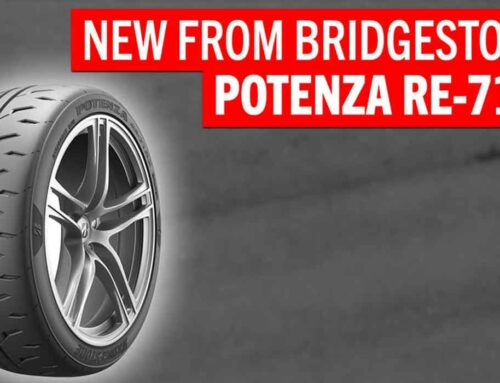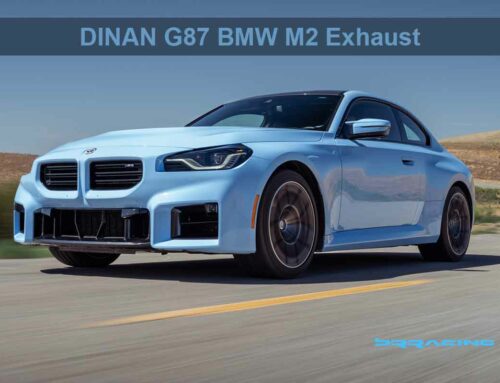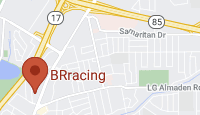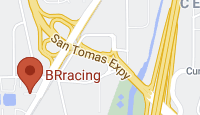BRAKE ROTOR OPTIONS – Which One is Right For You?
When customers are adding or upgrading their brake system, we often get asked the question about which brake rotor type should they order (plain, cross-drilled, slotted, J-hook).
The answer really comes down to the application(s). If the upgrade is being done just for the looks / aesthetics, then you can choose whichever design suits your fancy. Sometimes the brake manufacturer only offers one option. Like on MINI Coopers, when we upgrade from the stock brake package to the John Cooper Works (JCW) system, the rotors that come w that package are both cross-drilled and slotted. So, what does that mean…is this a compromise, or is this better?
Confusion even gets created when customers look at those cars that they know were designed w racing in mind by the factory, and they come w one type of rotor design…..therefore, that must mean that is the best option, as the factory has been doing this for years, and has engineers that are reviewing all the data and have the experience of years of racing. While that is true, it needs to be explored a little more to understand the assumptions originally made, and when those decisions were made. Take a look at the Porsche Cup Cars…by far the most successful factory race car program in existence. And what do the Porsche Cup Cars run? Well, that depends on the year of the Cup Car. From 2004 – 2012, the 996 / 997.1 / 997.2 Porsche Cup Cars came w Brembo cross drilled rotors. But, starting in 2013, w the new 991, the Porsche Cup Cars came with slotted rotors.
See pic from one of our customers new 991 Porsche Cup Car:
The difference here is due to two things, at the time that the brake decision was made for the first 996 Porsche Cup Car, the current thinking was that the cross-drilled was the best option, and secondly, this is what the agreement between Brembo and Porsche specified. Therefore, they came w those brakes. In the few years after that design decision (about 2002 really), the venting in the internal section of the brake rotor got much better, and the flow was designed in such a way that the thermal deviation from the inside edge to the outside edge of the rotor could be managed to be nearly the same (thats why if you cut a slotted rotor in half, you will see the cooling vanes on the inner edge are not the same as the cooling vanes on the outer edge….also, the air entering the inner edge of the brake rotor is cooler, and as it travels thru the vanes of the brake rotor, the thermodynamic heat transfer from the metal rotor to the passing air increases the temperature of the passing air, and therefore, the rate of flow of the air has to be greater as you approach the outer edge of the rotor to create the same rate of heat transfer, so that the brake rotor face is nearly the same temperature across the face). Therefore, you could implement a slotted design to deal w the brake pad gasses, and still get the cooling across the brake rotor face needed. Ahh..so there is another element to this as well besides just cooling…the expelling of the gasses from the brake pads. As the brake pads heat up, the pad face turns into a plasma…which is a gas, and gas needs to expand. By creating relief slots, this gas can expand allowing the brake pad face to stay firmly against the brake rotor face where the friction interaction occurs. If this gas did not have a place to release, the pad would start to float, and the friction interaction would be reduced.
There are some other elements to be considered as well, besides just the cooling of the rotor face and the expanding of the brake pad plasma gas.
Here are the various options and some tradeoffs:
BREMBO Cross-Drilled 2 piece rotor
Drilled: drilled brake discs are suitable for a wide range of applications, operating temperatures and driving environments (especially wet weather).
* Benefit: offers the highest initial brake pedal response of all the available disc face types while continuously refreshing the braking surface and being also typically a bit lighter.
* Drawback: Drilled discs are generally more prone to heat checking and thermal cracking if used consistently at extremely high temperatures. This however, really depends on the track, driver, and chassis setup…
.and even more, the drivers awareness of how to cool them AFTER a track session (as mentioned before, only track sessions will generally generate the significant levels of heat in the rotor where stress cracking will occur)….if the user does NOT do a proper cool down lap, you can literally hear the rotor talk to you after the track session, and it will be “pinging”…the sound of the metal cracking as the metal cools NON-uniformly across its surface and in the depths of the metal. On our customers race cars, we have seen the life of the rotor be halved by not cooling the brakes properly after a track session. However, don’t read this to understand that even w proper cooling, the drilled rotor will last as long as a slotted rotor…it will still have a shorter life than a slotted rotor.
BREMBO Type I Slotted Rotor
Type I: Brembo “8 straight – slot” face type with an emphasis on stable brake feel and improve resilience against thermal cracking.
* Benefit: stable braking feel at all temperatures, low disc wear, and continuously refreshing the braking surface for optimum performance.
* Drawback: The Type 1 standard disc face has the lowest “initial response” or “bite” compared to Brembo Drilled, Type III or Type V discs.
BREMBO Type III Slotted Rotor
Type III Brembo – (aggressive face type): motorsport developed face type with an emphasis on high initial response while maintaining a smooth pedal release.
* Benefit: highest overall braking confidence, control, and allows driver to spend less time on the brake pedal. When chasing the fastest lap time, less time on the brake pedal typically leads to a quicker lap time. (In our view, one of the best brake rotors on the market)
* Drawback: Any disc with an aggressive face type like the Type III will have a higher chance to mechanically abrade the pad and disc surface leading to quicker or uneven pad wear. However, this really depends on variables such as car setup or track layout.
Type V Slotted Rotor
Type V (Endurance face type): motorsport developed face type with marginally less initial response compared to the type III face type. The Brembo Racing type V face type was also designed to have lower pad and disc wear for certain long distance endurance races (mostly 10, 12 and 24 hour races).
* Benefit: braking modulation and control similar to Type III, while offering lower overall pad and disc wear on the track.
* Drawback: While the most well balanced of all Brembo face types, Type V discs generally do not have as high of an initial response compared to the Type III.
AP Racing J-Hook Slotted Rotor
AP Racing J-Hook Slotted Rotor – (aggressive face type): motorsport developed face type with an emphasis on high initial response while maintaining a smooth pedal release.
* Benefit: highest overall braking confidence, control, and allows driver to spend less time on the brake pedal. When chasing the fastest lap time, less time on the brake pedal typically leads to a quicker lap time. (In our view, one of the best brake rotors on the market, much like the Type III from Brembo, but harder to get, and less fitments available, slightly higher price)
* Drawback: Any disc with an aggressive face type like the Type III will have a higher chance to mechanically abrade the pad and disc surface leading to quicker or uneven pad wear. However, this really depends on variables such as car setup or track layout.
NET – all the current brake rotors are very good, and its only when subjected to high heat environments (like track use, or long canyon carving drives) that the brake rotor will make any difference….and even then, the life of rotor will be more directly affected by the cooling provided to the braking system). So, choose wisely, but choose any to fit your desires, now that you know the trade-offs of each approach
BRracing – educated & proven performance solution













Leave A Comment
You must be logged in to post a comment.